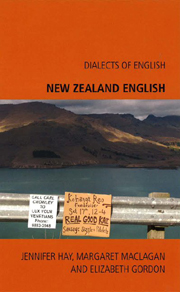Book contents
- Frontmatter
- Contents
- Preface
- Maps
- 1 Geography, Demography and Cultural Factors
- 2 Phonetics and Phonology
- 3 Morphosyntax
- 4 New Zealand Vocabulary and Discourse Features
- 5 The Origins of New Zealand English
- 6 Variation within New Zealand
- 7 Selected Bibliography of Works on New Zealand English
- 8 Sample Texts
- Bibliography of Cited Works
- Index
2 - Phonetics and Phonology
Published online by Cambridge University Press: 12 September 2012
- Frontmatter
- Contents
- Preface
- Maps
- 1 Geography, Demography and Cultural Factors
- 2 Phonetics and Phonology
- 3 Morphosyntax
- 4 New Zealand Vocabulary and Discourse Features
- 5 The Origins of New Zealand English
- 6 Variation within New Zealand
- 7 Selected Bibliography of Works on New Zealand English
- 8 Sample Texts
- Bibliography of Cited Works
- Index
Summary
When visiting other English speaking countries, New Zealanders often report communication difficulties. These difficulties usually involve particular sounds. One example we heard recently was of a New Zealand doctor working in Australia, who asked a patient if he was feeling better. The doctor was very surprised at the patient's negative response, since he appeared to have made a good recovery. Fortunately the patient continued ‘I'm not feeling bitter’ and they eventually worked out where the misunderstanding was. A similar story involves a young New Zealand tourist wanting to withdraw forty pounds from a London bank. When asked how she wanted the money she replied ‘four tens, please’. The puzzled teller said ‘but we don't have fourteens’. Ten and better both have the same vowel sound – a sound we refer to as the DRESS vowel. The New Zealand DRESS vowel is prone to different types of misunderstanding in Australia and Britain.
As discussed in Chapter 1, the largest number of original settlers to New Zealand came from Britain, with most coming from the south-east of England, and modern NZE reflects this. For example, like the English of most of England and unlike most varieties of American English, the /r/ sound is not pronounced word finally or before a consonant as in words like car, card or butter. The technical term to describe varieties which don't produce this /r/ is non-rhotic.
NZE is a southern hemisphere variety of English, and the variety to which it is most similar is Australian English. New Zealanders and Australians are very aware of the differences between the two varieties.
- Type
- Chapter
- Information
- New Zealand English , pp. 14 - 46Publisher: Edinburgh University PressPrint publication year: 2008



